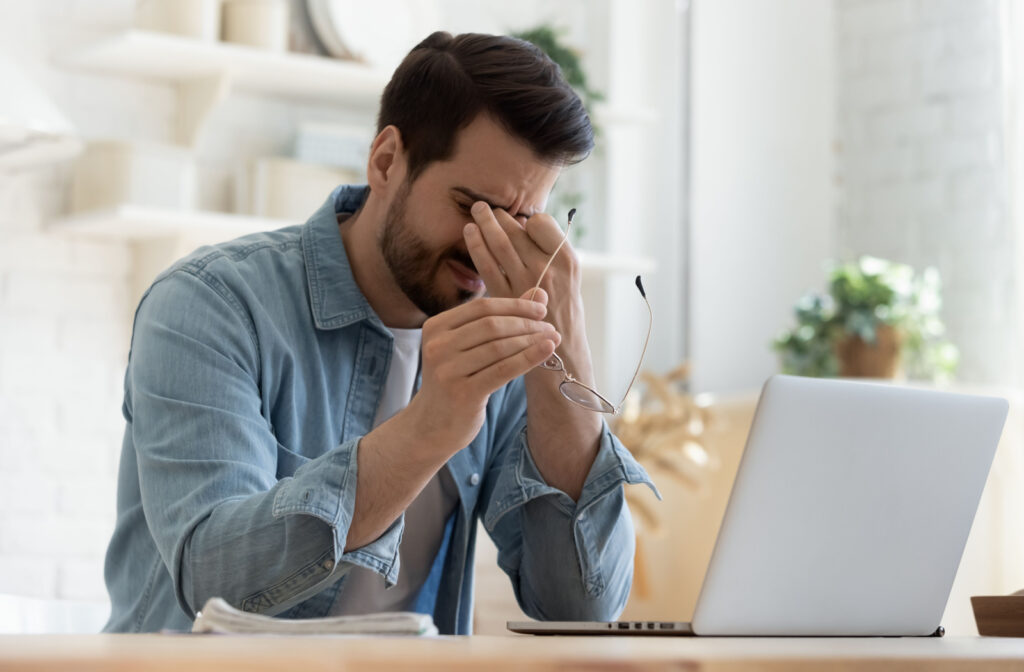Many people spend hours on a computer or using digital screens daily in our digital age. Digital eye strain, or computer vision syndrome, commonly affects those who frequently use technology.
Blurry vision, tired eyes, and eye pain are common symptoms of eye strain. But non-eye-related symptoms, such as a sore back, shoulders, neck, and even headaches, can all accompany eye strain.
Typically, the symptoms resolve quickly with some basic care. But you should see your eye doctor for an eye exam if you’re getting eye strain often or the symptoms aren’t subsiding.
What Is Eye Strain?
Eye strain is a common condition that typically comes with intensely focusing on digital devices, such as computers or cellphones, but also from reading, driving long distances, sewing, or other detailed work.
Does Eye Strain Cause Headaches?
Headaches can certainly be a symptom of eye strain. Although, they are not typical and rarely limit activity. Headache can be related to eye strain if you’re experiencing a headache in conjunction with other symptoms of eye strain, which we’ll discuss below.
An eye strain headache is typically less painful than migraines or tension headaches. And the discomfort will usually subside shortly after stopping the activity causing the eye strain. Pain will often be directly behind your eyes if the headache is also related to eye strain.
Symptoms of Eye Strain
Eye strain symptoms vary between individuals, and there’s no one-size-fits-all solution. But common eye-related symptoms include:
- Watery eyes
- Burning, itching, or dry eyes
- Light sensitivity
- Fatigued eyes and having trouble keeping them open
- Blurry vision
Non-eye-related symptoms of eye strain include:
- Neck, shoulder, or back pain
- Trouble concentrating
- Headaches
None of these symptoms by themselves necessarily point to eye strain. For example, many of the eye-related symptoms could point towards dry eye disease, and a sore back may be unrelated. It’s important to see your optometrist to know for sure.
Preventing & Treating Eye Strain
It may be nearly impossible to prevent eye strain 100%, especially with how often many of us need to use computers or other digital screens nowadays. But prevention and treatment strategies for eye strain often go hand-in-hand.
Treating Eye Strain
Fortunately, eye strain symptoms often resolve themselves once you try a few things:
- Practice the 20-20-20 rule. Every 20 minutes, take 20 seconds to look at something 20 feet away from you. This break allows your eyes to relax and refocus on something else.
- Take a break from whatever you’re doing that’s causing your strained eyes.
- Use lubricating eye drops to keep your eyes from being dry and adding to the symptoms.
Preventing Eye Strain
Lowering your risk for eye strain or preventing it is ideal, and there are a few things you can do to help:
- Adjust your screen so it’s just below eye level and approximately an arm’s length away.
- Eliminate glare with glare filters on your screens or sunglasses while driving.
- Adjust lighting to minimize glare.
- Use lubricating eye drops.
- Blink often.
- Ensure you have an up-to-date prescription if you wear glasses or contacts.

When to Talk to Your Optometrist about Your Symptoms
Eye strain is common and often resolves quickly without any lasting damage or complications. But that doesn’t make it any more pleasant to deal with at the time.
But it’s a good idea to seek an emergency appointment with your optometrist if you experience pain in or behind your eyes that doesn’t subside with the above strategies or if it continues for several days. A prompt examination can allow your optometrist to rule out potentially more serious eye conditions.
Get Your Eyes Checked by Your Eye Doctor
There isn’t a 100% effective method of preventing eye strain, but regular comprehensive eye exams may help prevent underlying factors in developing eye strain. The American Academy of Ophthalmology recommends that most people receive an eye exam every 1 to 2 years, depending on age and other health factors.
Your eye doctor may recommend more frequent examinations if you have risk factors for eye strain or other eye-related conditions. Contact us at Dr. Jennifer L. Shane & Associates to request an appointment if you need your eyes examined or have eye strain symptoms that won’t go away.



